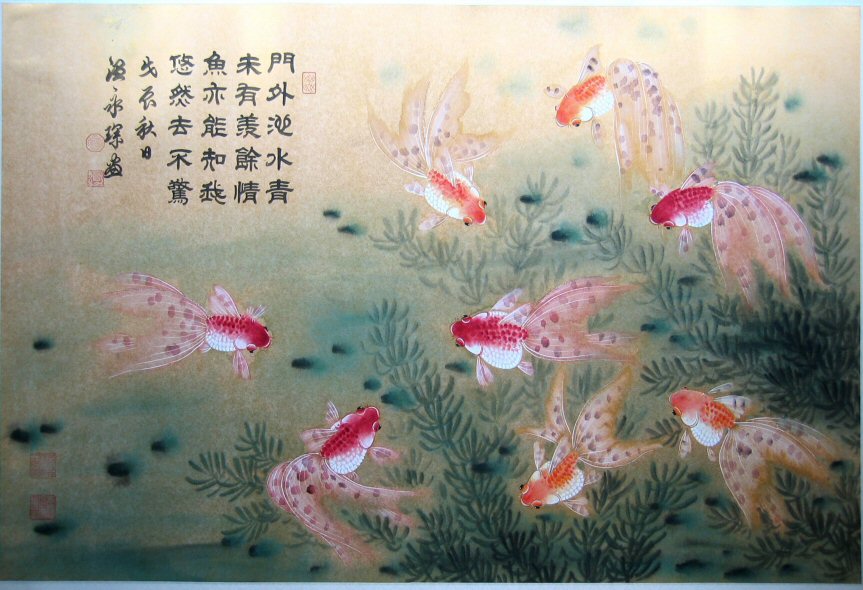
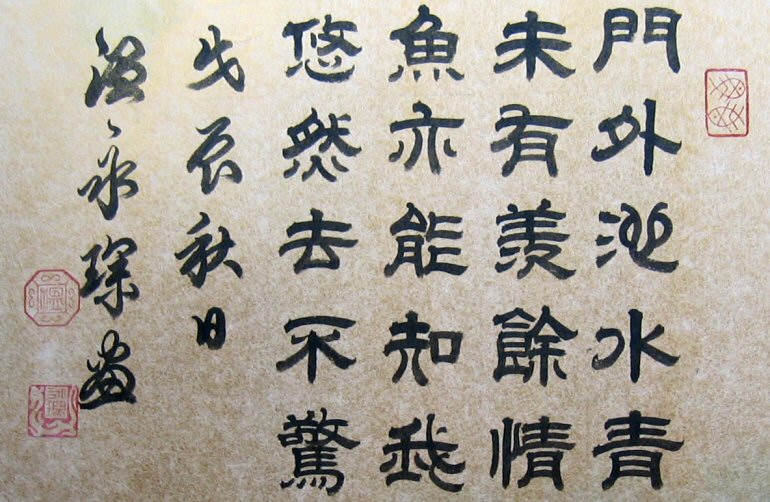
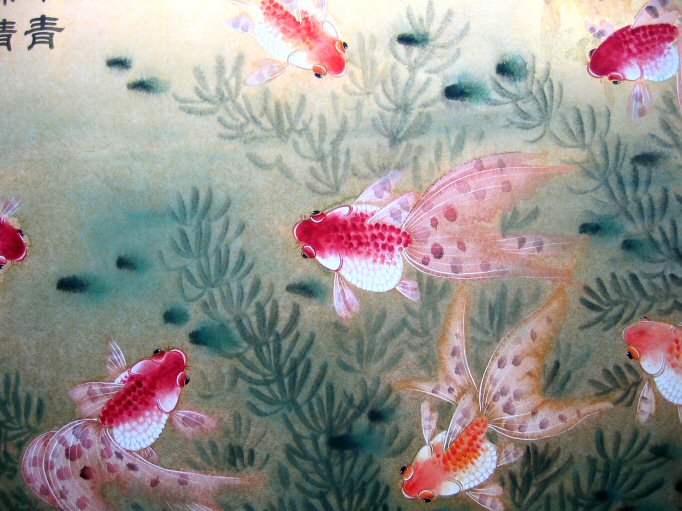
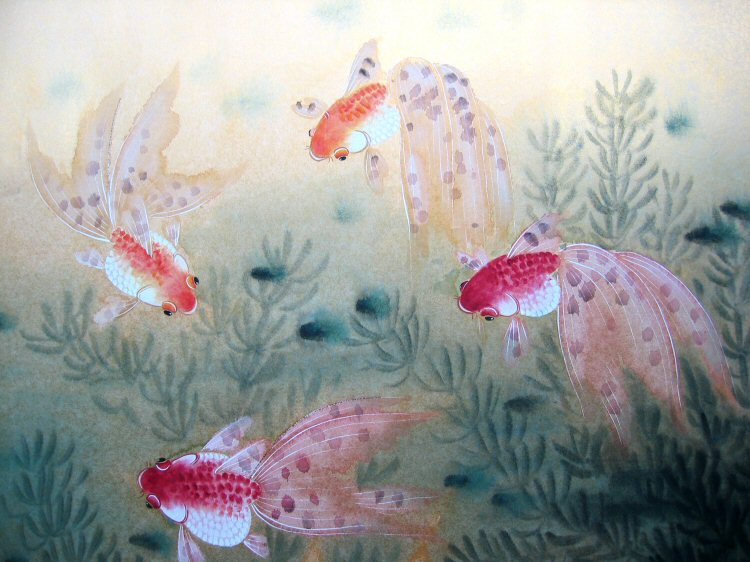




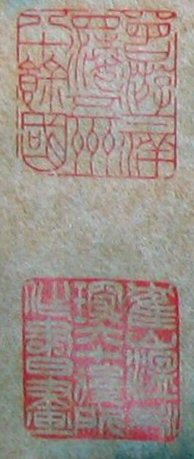
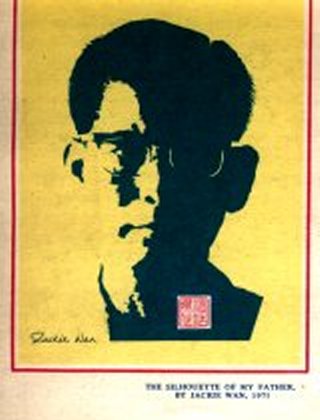
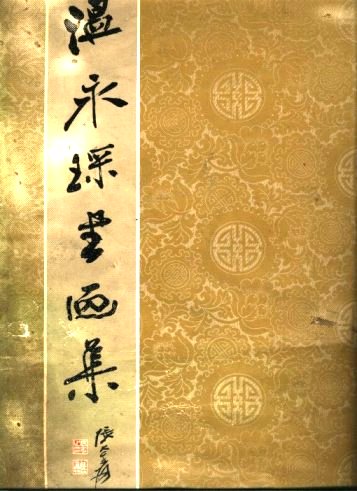
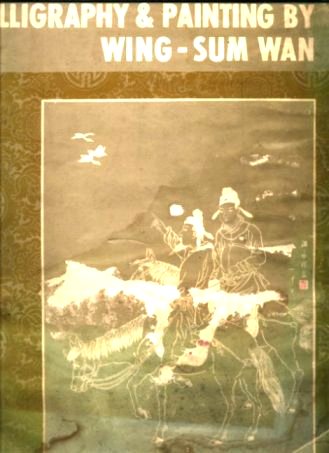
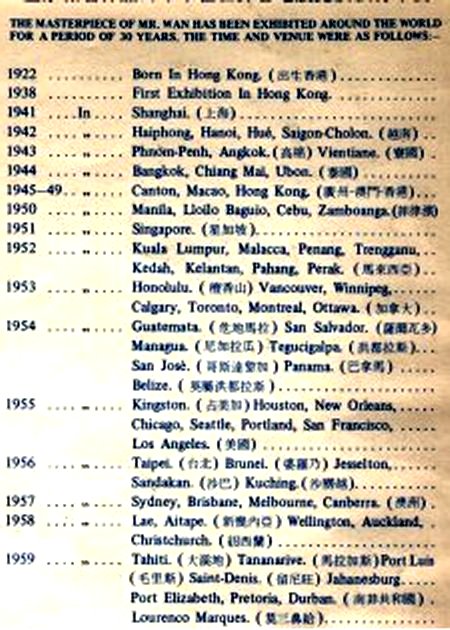
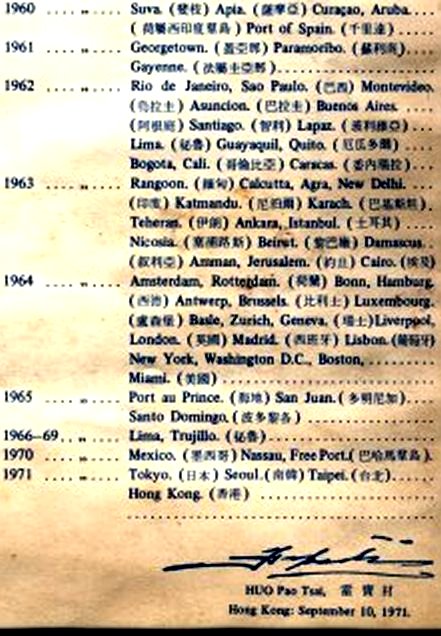
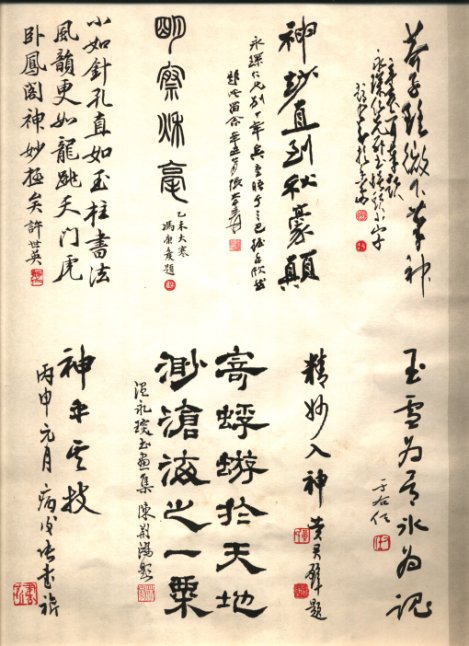 ,
,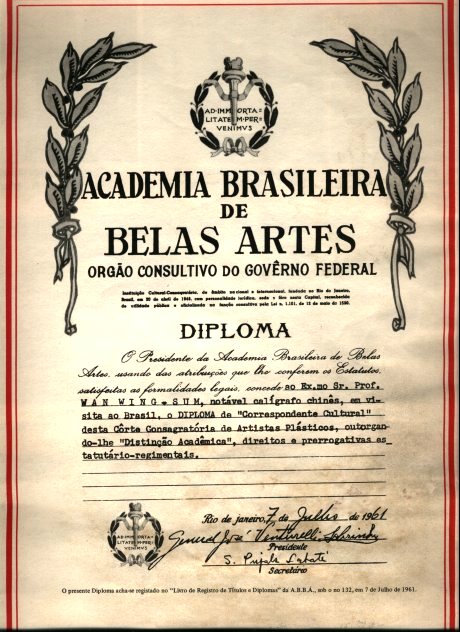
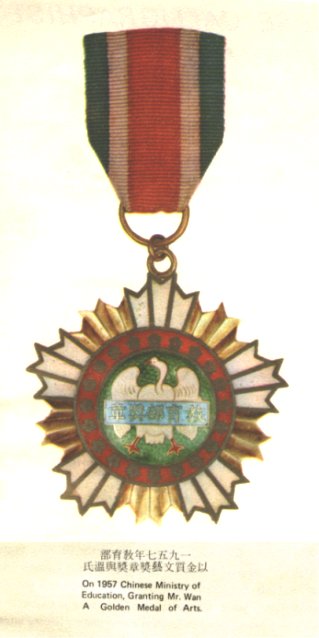
Gold Fish Watercolor Painting by Mater Chinese Artist Professor Wan Wing-sum (1922-1995)
溫永琛(1922-1995)金魚水彩畫
(The following is the forword by Chang Chi-yun to a folio of Professor Wan Wing-sum, dated March, 1971)
=================================================================================
WING-SUM WAN, A GREAT CHINESE CALLIGRAPHER AND PAINTER OF OUR TIMES
In his late forties, Professor Wan Wing-Sum, a native of Ngohan Hsien (Country), Kwangtung Province, Republic of China, is a world renowned Chinese Calligrapher. Born and brought up in a poor family in Hong Kong, he ceased attending school at the age of 12 and was obliged to enter trade. Nevertheless, being profoundly interested in calligraphy, he spared no effort to make use of what little time at his disposed to imitate and emulate the works of famous ancient calligraphers. It was natural that success should have come to him as a reward for his perseverance and constancy. From the artistic point of view, ere he came of age, he was widely known on account of his accomplishment; his works suggest the grandeur of the mountain and the beauty of the stream. After having an exhibition of his works at Shanghai, he was eulogized as the genius of Lin-nan ( Kwangtung) and so was the comment by the Sun Pao, a leading vernacular paper in the metropolis.
Being at home with different forms and styles of Chinese calligraphy from time immemorial, Mr. Wan has acquired his skill by copying and imitating ancient works, such as the inscriptions of turtle shells, bones, bronze ceremonial bells and vessels (Ting); the bamboo letters of the Hen (207 B.C. - 219 A.D.) rubbings from the stones tables of the Wei Dynasty (386-535 A.D.), and the scripts of the Tang dynasty (618-935A.D.), and the Sung dynasty (960-1127 A.D.). His imitation of the hand of Wang Hsi Tze, the greatest calligrapher of the Tsin dynasty (264-419 A.D), is a fine piece of art, in which few can excel him.
What seems incredible is his ability to scribe no fewer than 3,000 characters within so infinitesimal a space as one square of an inch. The characters are hardly discernible under naked eyes; and yet when they are properly amplified the beauty resulting from the proportion of the components to the whole of the character and also from the sprightliness and vigor of the style, produces a rare delight to the eye. On being enquired how he comes by such perfection, he is quoted as saying: "Imperturbability of the heart, brightness of the eye, and firmness of the hand." Does it not sound very similar to what is taught in the GREAT LEARNING about determination, calmness, tranquil repose, careful deliberation, and attainment of the desired end? His recent works on flowers, birds and ancient figures of the Chinese paintings are particularly magnificent.
During the Sino-Japanese War, Wan sought refuge in Siam (now Thailand) and Indo-China (now Vietnam). Praised by French reporters as the Lynx-eye Calligrapher, he was thus made known the world over. In the past ten odd years after the victorious conclusion of the war, Wan has been traveling extensively along the coast of the Pacific, visiting such countries as the Philippines, Malaysia, North Borneo, Singapore, New Zealand, Canada, the United States, Guatemala, San Salvador, Honduras, Nicaragua, Costa Rica and Panama. Recently he also visited Fiji, Tahiti, New Guinea, Mauritius, Reunion Madagascar, Mozambique, Union of South Africa, Curacao, Jamaica, Trinidad, British Guyana, Surinam, Cayenne (French Guyana), Venezuela, Brazil, Paraguay, Uruguay, Argentina, Chile, Bolivia, Peru, Ecuador, and Colombia. Wherever he went, he was enthusiatically received by government officials and people alike. Heads of States would readily grant his audience and his overseas Chinese brethren would be overwhelmed with joy to have him in their midst. At times he would demonstrate his skill in public, thus commanding hearty admiration. At Singapore, films depicting his works are often shown in cinema theatres. At Hollywood, newsreels and educational films are made to introduce his unique accomplishment in this specific field of art. He has been invited on several occasions to appear on television in Canada and the United States and Australia, winning widespread praises from innumerable spectators. The Brazilian Academy for Fine Arts had granted him a permanent honorary membership. The Chinese Ministry of Education also granted him a golden medal of arts. Indeed, in him we find an ambassador of Chinese Culture at large.
It can be said that calligraphy is a symbol of Chinese culture. Owing to the unique structure of Chinese characters, many of them embody profound and subtle meanings and assume forms of indescribable beauty, so much that perhaps few other languages could be expected to emulate. The works of famous calligrapher of different dynasties are a legacy of aesthetic value appealing to our artistic soul. Such immoral works have enriched the spiritual assets of our nation. In Wan's works we find invariable quotations of famous sayings or proverbs by ancient sages, the wisdom of which is of great benefit to all. The sight of his works reminds us of a famous poem by Chang Hao (1032-1085), a great philosopher of the Sung dynasty, two lines of which are being translated as follows:
A silent spectator will find in everything its nature self.
With which his happy mood in different seasons coincides.
Indeed, no person with artistic taste can fail to appreciate the beauty of Wan's works, for there he realizes the universality of all things under the heaven.
It is, perhaps, for this reason that Wan's mission to so many countries around the world is of tremendous importance to his nation. He was not only exhibited Chinese art to the world but also propagated Chinese culture to humanity.
Immediately after Wan's arrival in Taipei we had the pleasure of making his acquaintance. Gentle and modest, youthful and vigorous, he is a scholar of high caliber. We are told that he will be soon on his way to South-East Asia, and then to Europe to complete his world tour. Let us take the opportunity to wish him his voyage and every success.
[張其昀作序於陽明山,時一九七一年三月]
溫永琛君, 廣東白鶴山人,現年四十九。君生於香港,年十二,以家貧失學,投身商業,惟篤好書法,工餘朝夕臨摩,百鍊千錘,乃成絕藝。其為書,勁拔如山,秀逸似川,壯美優美,兼擅其勝。年方弱冠,即負時譽,曾在上海舉行書法展覽,申報記者以“嶺南神童”稱之。
溫君綜覽歷代名家墨寶, 自甲骨、石鼓、鐘鼎、漢簡、魏碑,以至唐宋法帖,凡篆書、隸書、行書、草書、揩書之屬,莫不一一手描日臨,聚精會神,饒有心得,其所臨王右軍蘭亭序,尤稱神似。於小揩最擅長,能於一方寸內寫成三千字,在一枚郵票背面寫全部孝經。較世所謂蠅頭小揩,又遠過之,非肉眼所能辨認。若用擴大鏡觀之,則字字工整,疏密合度,氣韻生動,清麗多姿,洵為稀世奇珍。問其何以致此,則日“心靜、手定、眼明”,此即大學“定、靜、安慮、得”之教也。溫君近作,對國畫之花鳥人物,尤為卓妙。
抗戰時期,溫君避地於泰越二國。越南法國記者譽之為神眼書家(Lynx-eyed Calligraphic),已裴聲於國際間。勝利迄今,歷時廿餘年,溫君挾其神工絕技,遍遊太平洋沿岸各國,如菲律賓、馬來亞、婆羅洲、澳洲、紐西蘭、大溪地、檀香山、加拿大、美國、南非、東非、及中南美諸國。所至即席揮毫,傾動朝野,備受我僑胞及彼邦人士之熱烈歡迎。各國元首多親予接見,並有題贈。星洲戲院則放映其書翰真蹟,好萊塢電影公司則攝成新聞與教育片,美國、加拿大、澳洲、紐西蘭、秘魯,與巴西廣播電台,則邀其作電電視表演,觀眾均嘖嘖稱羨,歎為觀止。巴西國家藝術學院,贈以永久名譽會員,中華民國教育部,獎以金質文藝獎章,“文化大使”何多讓焉?
中國書法實為中國文化之象徵。中國文字構造合理,義旨宏深,行列整齊,書法美觀,非併音文字所能企及。歷代名家書法,莫不有聲有色,覽之心曠神怡,極富藝術價值。而中國歷史上不朽之作品,則有無盡藏之精神資源。觀溫君所作,無論長幅小頓,多錄古代聖哲嘉言,令人終身受用不盡。如程明道詩云:“萬物靜觀皆自得,四時佳慶與人同”精神志氣, 洋溢楮之外,供諸案頭,涵泳欣賞,使人體會“廊然大公,萬物一體”之境界。故溫君,周遊列國不僅在展覽中國之藝術,亦為宏揚中國之文化。振一代之名筆,伸民族之正氣,其於號召海外僑胞對祖國之向心力,尤有不可言喻之鼓舞輿潛力。
溫君日前旅遊台北,幸得識荊。其人溫文爾雅,卓爾不群,年少英俊,而有高士之風。不日將重遊東南亞,再作歐洲之遊,壯哉此行!溫君乞為一序,因述所聞,書以歸之,敬表欣慕,並祝成功。
Click Here to See Other Hong Kong/Guangdong Paintings
Click Here to See Other Contemporary Artists' Paintings
Click Here to See Other Paintings
Click Here to Go Back to Homepage